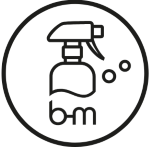Before you start
BUILD YOUR EFFICIENT CLEANING KIT
Make sure to stock up on these core items: Bicarbonate of Soda, Soda Crystals, Oxygen Bleach, and Citric Acid. Don’t forget to add liquid Castile Soap, as it is especially helpful when making up cleaning solutions. Armed with these must-have cleaning champions, you’ll be able to make a variety of cleaning solutions faster than you can say spotless. And for a home that smells as good as it looks, don’t skimp on Essential Oils. Shop Natural Ingredients
When it comes to making your own cleaning solutions – avoid using bottles that previously held chemicals. Over time, plastic can break down and contaminate cleaning solutions when exposed to their ingredients. Opt for sturdy glass spray bottles instead. Glass is non-reactive, which means that the cleaning solution remains uncontaminated. Plus, you can use your glass bottle over and over again and even recycle it when it’s time to say goodbye. For optimal shelf life, store cleaning solutions properly labelled in amber or dark bottles to protect them from light.
We also recommend protecting your bottles with Silicone Bottle Sleeves. These not only add a pop of colour but also keep your hands insulated and prevent slipping. Plus, colour coding makes it easy to identify which solution you’re using. Shop Bottles & Jars
But why stop there? You can also minimize waste and save money by opting for reusable materials like Microfiber Cloths. Discover more
TAKE SAFETY PRECAUTIONS
Make sure there’s good airflow and be careful not to breathe in the ingredients or get them in your eyes or on your skin. Natural options can also irritate. Whenever you can, wear rubber gloves – even something as mild as Bicarbonate of Soda can dry out your hands.
UNDERSTAND THE DO’S AND DON’TS
Cleaning solutions made from Natural Ingredients like Citric Acid, Bicarbonate of Soda, Castile Soap, Soda Crystals and Oxygen Bleach are incredibly effective and affordable. With the right combination of these ingredients, your entire home can shine without the use of harsh chemicals.
However, it‘s important to note that not all DIY cleaning recipes you, stumble upon on the internet are safe or effective. Some ingredient combinations simply cancel each other out whilst others cause dangerous reactions that can harm your home and health. So, before you start experimenting with different ingredient combinations, take a moment to get familiar with the dos and don’ts of mixing natural ingredients. Alternatively, feel free to try one of our safe and effective recipes on our website. Browse Recipes
RECIPES FOR DESASTER:
Hazardous Solutions
If you’re using a shop-bought cleaner, it’s best not to mix it with anything else. Before you get creative with the products under your sink, be cautious. Some products that are safe on their own can become dangerous when combined with others. Bleach is a major concern. Never mix bleach with other substances; instead, dilute it heavily with water for the safest use. Vinegar, often found in many online cleaning recipes, doesn’t mix well with most other ingredients and causes significant problems when mixed together. Combining vinegar or Citric Acid with Bleach, Hydrogen Peroxide, or Oxygen Bleach creates toxic fumes that can lead to severe respiratory problems. Here are a few things to be extra careful about.
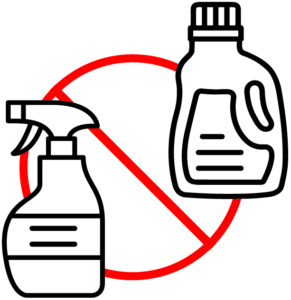
Combining different shop-bought Cleaners, especially drain Cleaners
The temptation to mix different shop-bought cleaners (especially when dealing with a clogged drain) can be strong. However, store-bought cleaners can contain different chemicals, that, when combined, can produce toxic fumes, chemical burns, and even explosions.
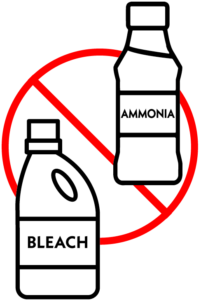
Bleach + Ammonia
This combination can produce toxic chloramine gas vapours (shortness of breath and chest pain).
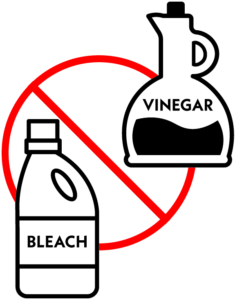
Bleach + Vinegar /Acids
This combination can produce toxic chlorine gas (coughing, breahting problems, burning and watery eyes).
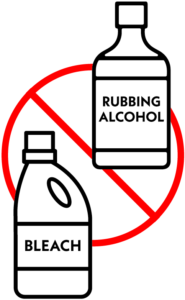
Bleach + Rubbing Alcohol
Creates chloroform when combined (highly toxic).
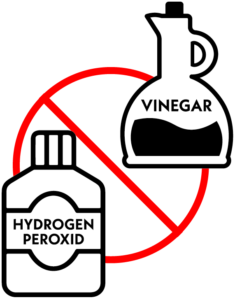
Hydrogen Peroxide (compound of Oxygen Bleach) + Vinegar/Citric Acid
Creates highly corrosive acid (peracetic acid) when mixed (can irritate the skin, eyes, and respiratory system).
Ineffective or Gunky Solutions:
Never mix acids like Citric Acid or vinegar with bases like Bicarbonate of Soda, Soda Crystals, or Castile Soap in the same bottle when making a cleaning solution. For the solution to work effectively, it needs to be either acidic or alkaline and not both. Mixing acids and bases causes them to react and cancel each other out (learn more about Factor Chemistry). So, keep your cleaning solutions on one side of the pH spectrum for maximum effectiveness!
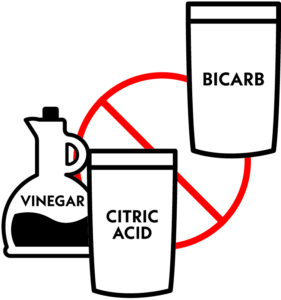
Vinegar + Bicarbonate of Soda
You might have stumbled upon a popular suggestion online about combining vinegar and Bicarbonate of Soda in a bottle for cleaning purposes. We hate to burst the bubble but – it’s a total hoax! Let’s get into the science of it. When Bicarbonate of Soda mixes with an acidic solution, like Citric Acid or vinegar, it creates a chemical reaction that produces carbon dioxide, forming bubbles. These bubbles can be helpful in lifting dirt from surfaces, but once the reaction is over, all you’re left with is weak, salty water that won’t do much cleaning.
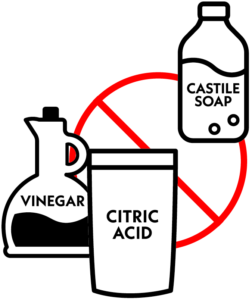
Vinegar/Citric Acid + Castile Soap
Likewise, when vinegar or Citric Acid is mixed with Castile Soap, it causes a chemical reaction that breaks down or unsaponifies the soap. The soap gets back to its original oils and leaves behind a curdled and oily mixture. Not only is this mixture ineffective, but it’s also a waste of both time and money. Plus, it can leave behind a white film on surfaces.
Damaging Surfaces:
Even Natural Cleaning Ingredients can harm certain surfaces if not used properly. For instance, acids and bases can actually damage waxed or unfinished wood, as well as marble, granite, and natural stone. Over time, they can even wear away at the protective sealant, causing it to lose its shiny lustre. As a general rule, it’s always a good idea to test a cleaner on a small, inconspicuous area before going full-on with the spray bottle to ensure that your surfaces stay sparkling and unharmed.
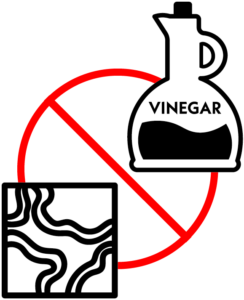
Surface Damaging Solutions
Make sure to use the right cleaner for the surface you’re cleaning.
Fortunately, our cleaning recipes always come with safety instructions and specific recommendations for surfaces.
MAKE SMALL BADGES AND LABEL THEM
Making your own cleaning solutions at home is a fantastic way to avoid chemical preservatives and have full control over the ingredients used.
However, these homemade cleaners tend to have a shorter shelf life than commercial products, so it’s best to prepare a small batch as and when they’re needed.
For optimal results with your DIY cleaning solutions and to prolong their shelf life, consider using boiled or distilled water instead of tap water. Tap water is not sterile and contains minerals that can result in streaks and spots. This simple adjustment will help your homemade cleaners last longer (around 4-8 weeks). If you notice any strange odour from the solution, just dispose of it and prepare a new batch.
To keep things clear, be sure to label your homemade cleaners with a detailed list of ingredients and their intended use. This way, you’ll always know what you’re dealing with and can respond appropriately in case of an emergency. We’ve made some waterproof labels with our favourite recipes or blank ones for you to fill in, making the process even simpler. Shop our Spray Bottle Labels
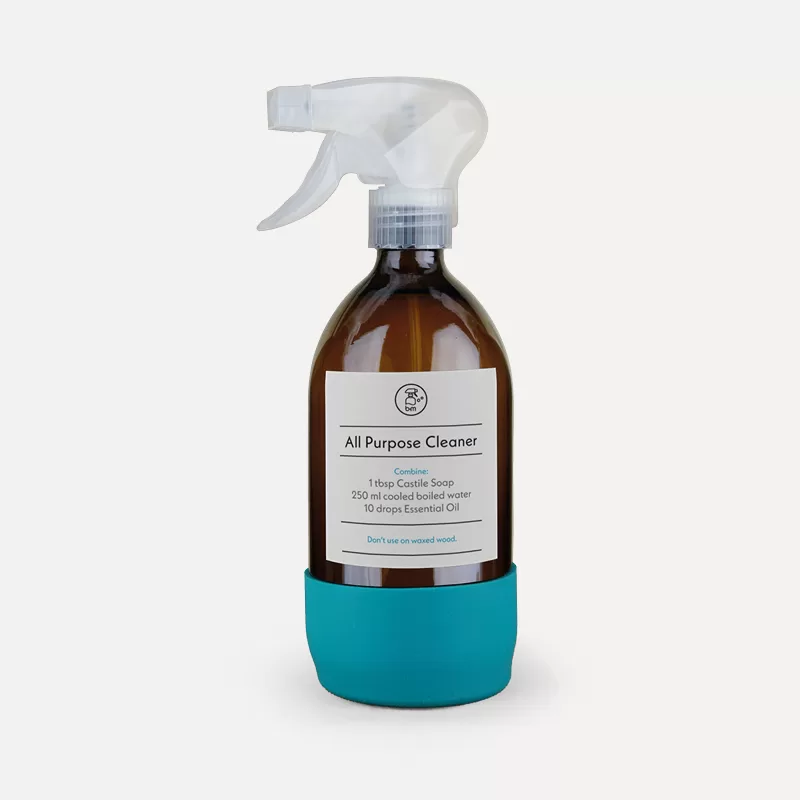
STORE SAFELY
Let’s make sure our little ones and furry friends are safe! Keep all cleaning products, even natural ones, out of reach from curious hands or paws. Lock them up in a cupboard and place them in a cool, ventilated area. If you decide to transfer them into jars, label the jars accurately so there’s no confusion. No worries, we’ve got you covered with both labels and jars. Shop here
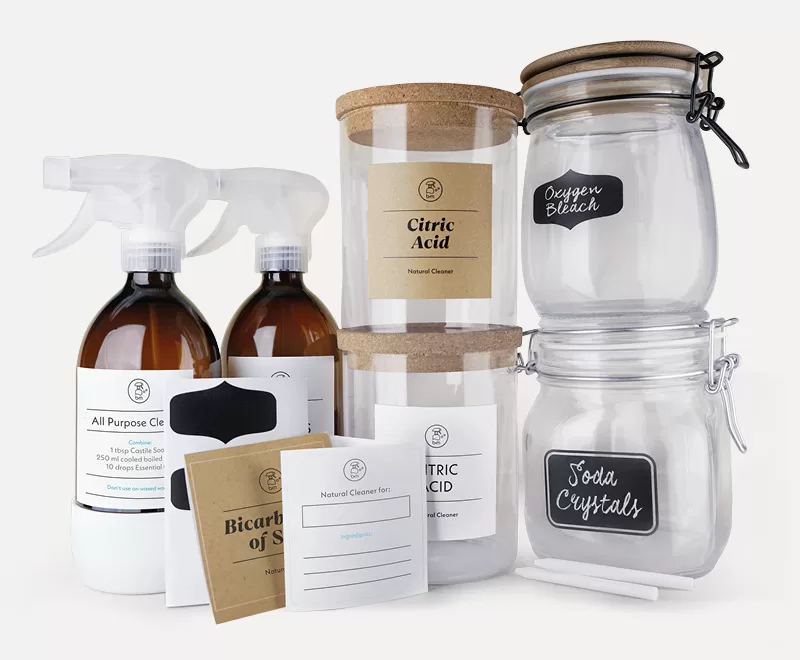
TAKE SMALL STEPS AND EXPERIMENT!
We know, this can feel overwhelming at first, but remember: This isn‘t a race – it‘s about taking small steps in the right direction. No need to stress yourself out trying to make all of your own eco-friendly products – it’s perfectly fine to switch between buying and DIY-ing. These changes will only last if they make you happy and if they fit your lifestyle and meet your standards.
A good starting point is to use up what you already have, to avoid waste. When it’s time to re-stock, consider replacing one item at a time with a natural alternative. Not only will this cut down on overwhelm, but it’ll give you time to play around and find the recipes that work best for you and your home. As you go along, you’ll be able to tweak and customize these recipes to fit your personal preferences.
Remember, this can also be a lot of fun – you’ll love the scents you create and feel like a genius in the lab! So put your lab coat on and get experimenting! Browse Recipes
